Table of Contents
Understanding the Iterations View
Get full visibility into your team’s progress and delivery with Iterations. Track real-time work, analyze past iterations, and connect Git activity to project issues for accurate planning, retrospectives, and continuous improvement.
Overview
The Iterations page in LinearB provides a comprehensive visualization of development progress by integrating project management (PM) issues (from Jira or Shortcut) with actual Git activity occurring on related branches. This integration helps teams track work progress effortlessly and minimizes the manual effort required to update PM issues.
Each Iterations report is team-specific, meaning only issues linked to a particular team will be displayed. To activate Iterations, teams must be connected to Jira or Shortcut PM boards.
The Iterations page in LinearB provides a comprehensive visualization of development progress by integrating project management (PM) issues (from Jira or Shortcut) with actual Git activity occurring on related branches. This integration helps teams track work progress effortlessly and minimizes the manual effort required to update PM issues.
Each Iterations report is team-specific, meaning only issues linked to a particular team will be displayed.
It also serves as your team’s real-time dashboard for tracking iteration progress. It helps you visualize how well your team is executing work during a sprint, identify bottlenecks, and surface key delivery insights. This view is especially valuable during daily standups, mid-sprint reviews, and retrospectives. It helps you visualize how well your team is executing work during a sprint, identify bottlenecks, and surface key delivery insights. This view is especially valuable during daily standups, mid-sprint reviews, and retrospectives.

Setting Up Iterations View
How to Access Iterations
To open Iterations:
- Go to the Teams tab in the sidebar, and select Iterations.
- Select your team from the team switcher at the top.
- Choose an active or past iteration.
- Iterations loads automatically, and by default opens in the Completed page.
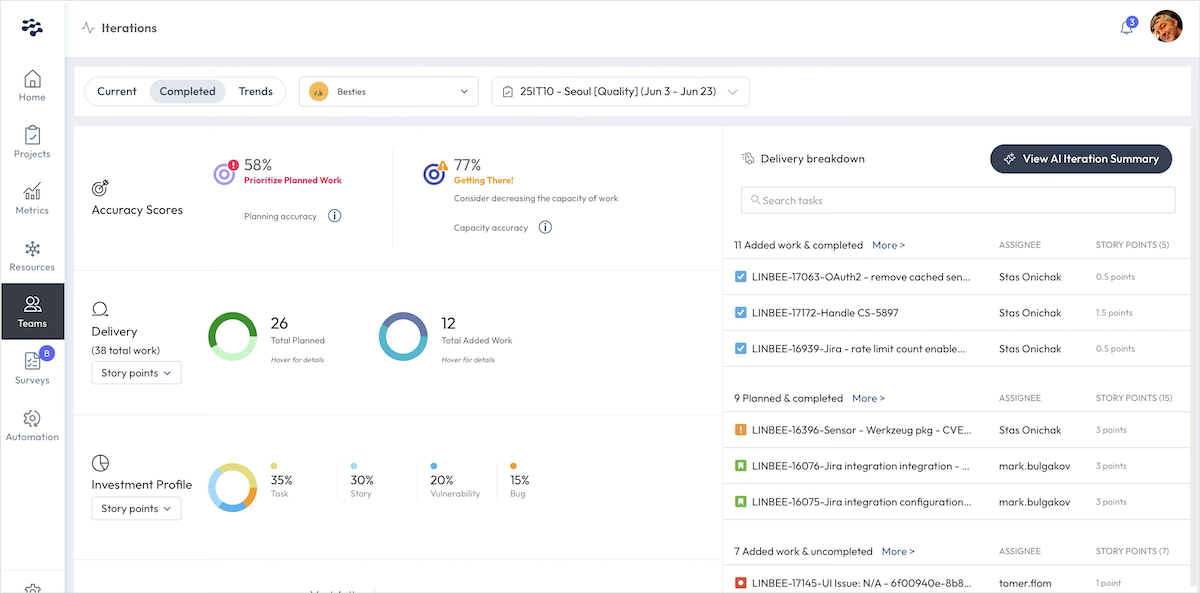
Before using Iterations, ensure your teams and project boards are properly configured:
- Creating, Editing, and Deleting Teams—Teams must be defined in LinearB before using Iterations. Learn how to set up teams.
- Connecting Project Management Boards—Connect your Jira or Shortcut boards so that Git activity maps correctly to PM issues. Use standard PR naming conventions—specifically include the Jira or Shortcut issue ID in the branch name, PR title, or commit messages. Set up PM boards here.

Choosing Between Current View and Retro View
LinearB offers two distinct Iterations views—Current View and Retrospective View. Both help you understand team activity and project health, but serve slightly different purposes based on timing and reporting needs.
Current Iteration View
Live insight into in-flight work and team activity
This real-time dashboard shows what your team is working on right now. It’s perfect for daily syncs, mid-sprint health checks, and spotting bottlenecks early.
Retroactive View
Analyze and reflect on completed sprints
Use Retro View to evaluate the outcome of a completed sprint. It shows how well the team delivered against what was planned and highlights key takeaways.


Comparison Table: Current vs. Retro View
Feature | Current Iteration View | Retroactive View |
Purpose | Monitor in-progress work | Analyze completed work |
Iteration Type | Active/ongoing sprint | Closed/past sprint |
Team Activity | Live status updates | Snapshot of final delivery |
PRs and Commits | Real-time branch and merge activity | Summarized and fixed at sprint end |
Unlinked Branches | Visible and actionable | Static list for review |
AI Iteration Summary | Not available | Available |
Use Cases | Standups, sprint execution | Retrospectives, planning improvement |

Understanding Iterations Data
Filtering the Iterations Report
Use filters in Iterations to customize what data you see:
- Issue Type Filter – Select specific work item types (e.g., Bugs, Stories, Tasks) to focus your view.
- Contributor Filter – Click on a developer’s name to view only issues they contributed to.
- Sprint/Iteration Selector – Choose the relevant sprint to switch between current and retrospective views.
These filters help teams zero in on priorities, manage workloads, and perform targeted retrospectives.
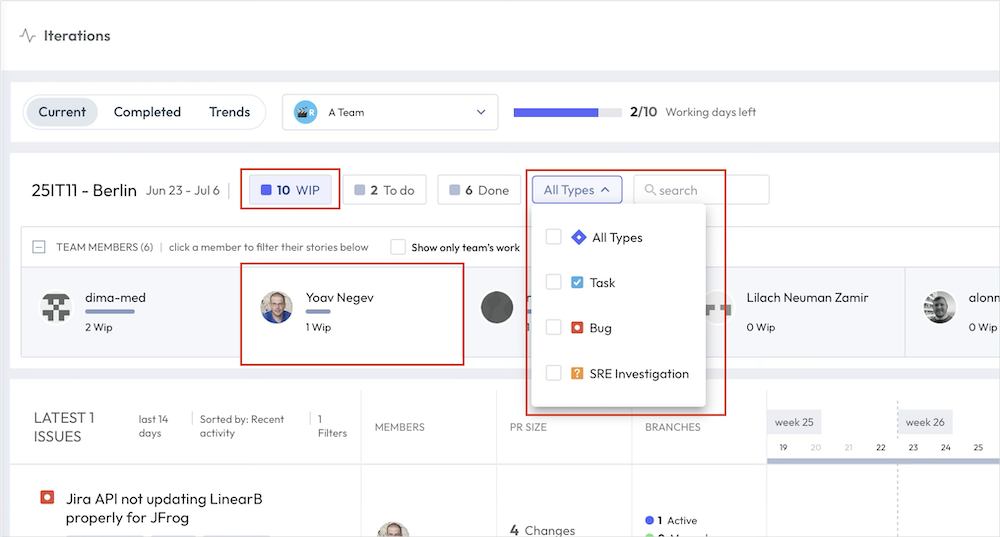

This section applies to both the Current Iteration View and Retroactive View. In the current view, it helps track work as it progresses. In the retro view, it supports analyzing what happened during the sprint and why. Use these metrics to monitor active workflows or reflect on delivery performance.
Iterations includes the following key data points:
PM Issue Details
- Issue Name, Story Points, and Status – Update issue status directly from LinearB using the dropdown menu
Contributors
- List of developers who contributed to an issue through commits, opening PRs, merging, or releasing code.
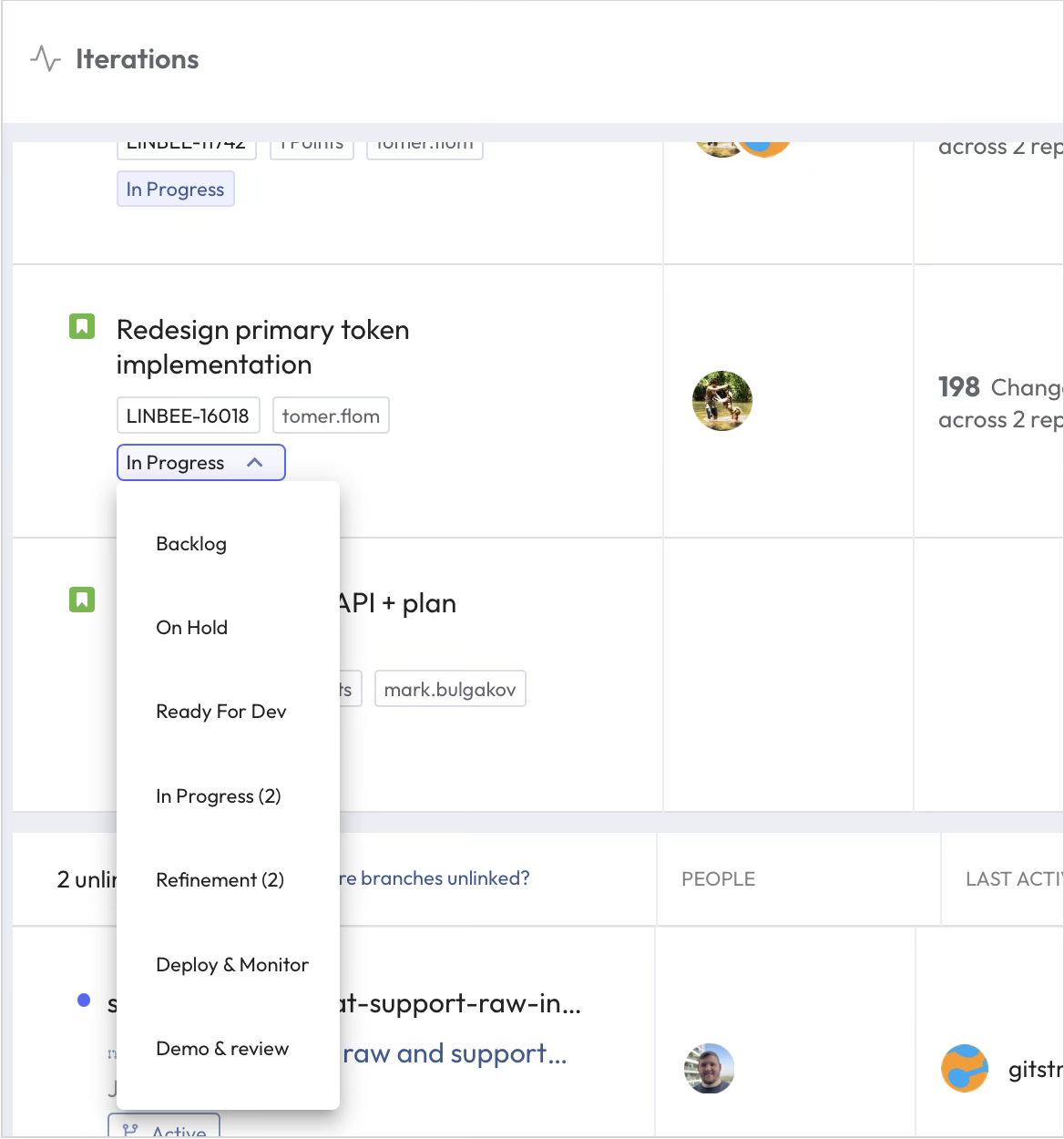
PR Size and Code Changes
- This number is the combined number of code changes (counted in lines of code) that were recorded for all the PRs that are associated with an issue. You also see the number of repositories that the branches linked to this issue are touching.
Branches
- Active Branches – Branches in the coding or open PR stage.
- Merged Branches – Branches that have been merged into the base branch.
- Released Branches – Merged branches that have been marked as deployed.
Issue Timeline
A daily summary of Git activity related to an issue, categorized as:
- 🟣 Work (Purple) – Commits, PRs opened, and reviews.
- 🟢 Completions (Green) – Merges and releases.
Hovering on each day will display the branch/PR activity breakdown for that day, including the name of the PR, activity, and contributor.
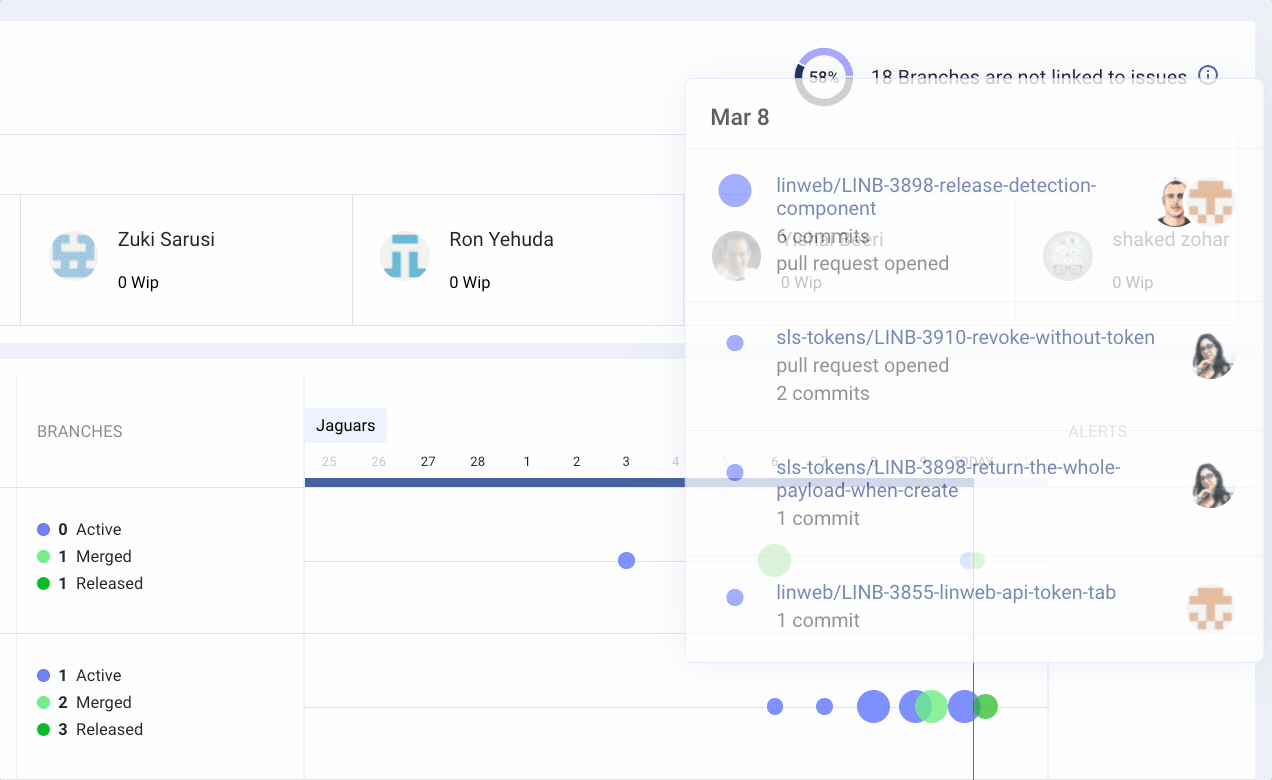

Unlinked Branches
Unlinked branches are Git branches created by your team that are not associated with any project management (PM) issue. These branches are listed at the bottom of your Iterations page and need to be linked manually to ensure accurate tracking of development progress.
Why Link Branches?
Linking branches to PM issues allows for:
- Better visibility into work progress within Iterations.
- Accurate synchronization between Git activity and PM tools (Jira or Shortcut).
- Reduced manual effort in updating issues.
How to Link an Unlinked Branch
To link a branch to a PM issue, follow these steps:
- Locate the unlinked branch at the bottom of your Iterations page.
- Click on the branch to open its details.
- Update the branch name or PR name by including the corresponding PM issue ID (e.g.,
feature/ABC-123-new-dashboard).
Best Practices for Linking Branches
- Always include the issue ID in the branch name when creating new branches.
- If a branch is already created, update the PR name to include the issue ID before merging.
- Ensure that all team members follow the PR naming conventions to avoid unlinked branches in the future.
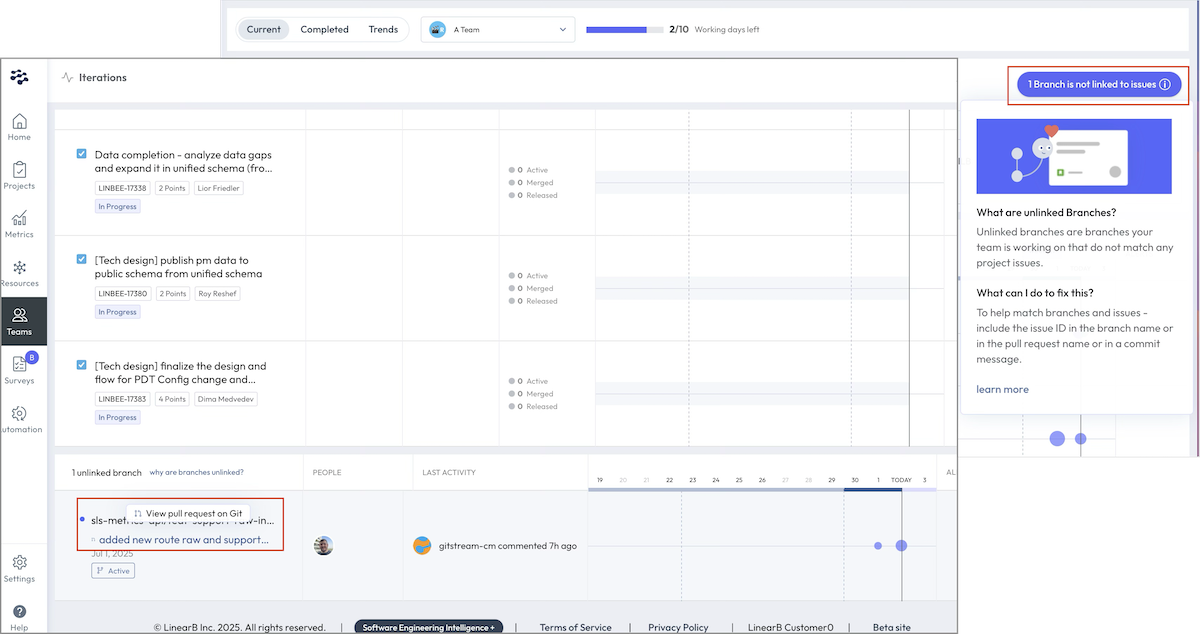

Iterations Retro View
The Iterations Retro View allows teams to analyze past iterations by selecting a previous sprint or week from the iteration filter at the top of the Iterations page. This provides a detailed report of development activity, enabling teams to evaluate their performance and improve future planning.
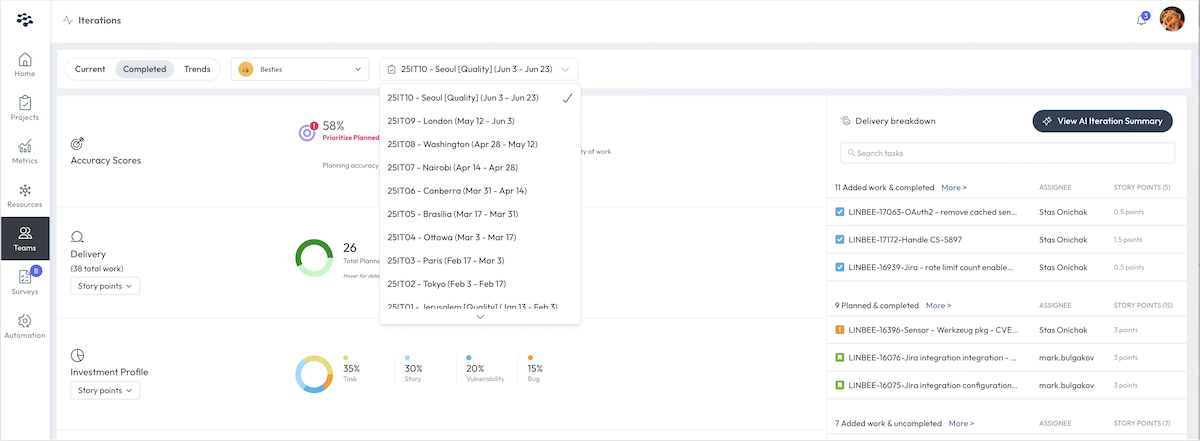
Key Metrics in the Retro View
Planning Accuracy – How Much Work Was Completed?
Planning accuracy measures the percentage of planned work completed within an iteration. This metric helps teams assess whether they are overcommitting or undercommitting to tasks.
- Formula: Completed Issues / Planned Issues)×100
- Guidelines:
- < 70% → Over-commitment risk (too much work planned, not enough completed).
- > 95% → Under-commitment risk (team may not be utilizing full capacity).
Delivery – How Well Did We Complete Our Planned Tasks?
The delivery breakdown categorizes all completed and incomplete tasks during an iteration.
- Completed – Story points or issues that were planned and finished within the sprint.
- Unplanned – Story points or issues added and completed after the sprint began. (Note: This does not include unplanned issues that were not completed.)
- Uncompleted – Story points or issues that were planned but not finished during the sprint.
- Planned – Story points or issues added before or within 24 hours of a sprint beginning.
Investment Profile – What Type of Work Was Completed?
The investment profile visualizes how work is distributed across different issue types. This data is sourced from the team’s project management platform (Jira or Shortcut) and helps teams understand how their effort is allocated.
People Effort – How Many Team Members Contributed?
This metric measures the percentage of active contributors in an iteration.
- A team member is considered "active" if they are assigned to an issue when it reaches the "Done" status.
- Formula:(Active Contributors / Total Developers)×100
- This helps gauge team participation and workload distribution.
Delivery Breakdown – What Issues Did We Work On?
A detailed list of all issues from the last iteration is displayed on the right side of the page, categorized by their status.
- Click “View more” next to any segment to see all relevant issues.
- Clicking on an issue redirects you to Jira or Shortcut, allowing deeper exploration of task details.
By reviewing these metrics in the Iterations Retro View, teams can gain insights into past performance, identify improvement areas, and optimize future sprints.


AI Iteration Summary
An AI-generated summary helps you make sense of each completed iteration.
To Access the AI Iteration Summary:
- Open any completed iteration in Iterations.
- Click View AI Iteration Summary.

What It Shows
- Overview of delivered work
- Unplanned tasks and scope changes
- Unlinked branches and contributors
- Risky PRs or code hotspots
- Planning suggestions for the next sprint
You can copy it in Markdown or share via link to help with retrospectives.


Summary
Iterations consolidates planning data and Git activity to give you deep, real-time and retrospective visibility into how work flows through your team.
- Use Current View to guide execution.
- Use Retro View to learn from delivery.
- Set up your naming conventions and integrations for accurate tracking.
Mastering Iterations helps every team become more consistent, transparent, and continuously improving.

Related Links
- How to Connect Jira or Shortcut Boards: Enable Iterations by linking your project management tool to LinearB.
- Teams: Creating, Editing, and Deleting: Make sure your teams are correctly set up before using Iterations.
- Understanding Project Delivery Trackers: Learn how LinearB tracks planned vs. delivered work.
- Enabling Team-Only Mode: Control who sees what on dashboards and metrics views.
- Using Team Iteration Summary in Iterations: Review completed tasks and achievements, ensuring clear visibility into past iterations.
- Managing AI Services in LinearB: Control LinearB AI services for your organization.
How did we do?